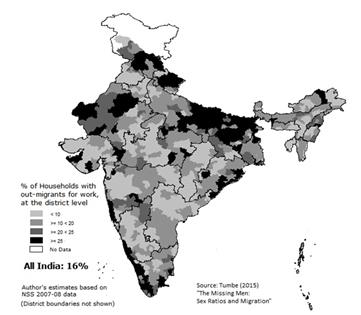Studies on skewed sex ratios in India typically focus on female deficits attributed to factors such as gender discrimination. This column finds that regions covering over 200 million people in India experience mass male out-migration with a marked impact on working-age group sex ratios. These regions are remittance economies with gendered labour markets that secure higher wages for men in the service economy but provide limited prospects for the upward mobility of women.
Despite the title, this column is not about the state of Indian kitchens. On the contrary, it is about a curiously neglected fact that male-dominated migration severely skews sex ratios in large parts of India with important labour market implications. While the all-India sex ratio in 2011 was 943 females per 1,000 males, the figure was 1,122 in Ratnagiri, a coastal district in Western India. What is even more remarkable is that the sex ratio of Ratnagiri has remained above 1,100 since 1881, reflecting a persistently high male deficit due to out-migration for 130 years! Nearly 40% of the households in Ratnagiri receive remittances from migrants working in Mumbai and to a lesser extent in Gujarat and the Gulf countries, characterising it as a remittance economy. This phenomenon of ‘missing men’, persistent mass migration and remittances is not restricted to Ratnagiri district alone. My research shows that it affects regions covering over 20% of the population of India or over 200 million people.
The ‘missing men’ phenomenon
Over 300 academic studies on sex ratios in India have focused on the phenomenon of ‘missing women’, a term coined by Amartya Sen, to describe female deficits arising from gender discrimination, sex-selective abortions and excess female mortality. Migration has typically been side-lined in discussions on sex ratios under incorrect assumptions of ‘low labour mobility’ in India that are based on two premises.
First, it is argued that the pace of urbanisation has been slower in India as compared to other countries on account of lower labour mobility but as I show in a forthcoming IGC (International Growth Centre) research paper, this has more to do with a remarkable demographic divergence between rural and urban natural growth rates in the poorer northern hinterland over the past four decades. The second argument for low spatial mobility revolves around statistics. Official migration estimates are based on Census or National Sample Survey (NSS) estimates of ‘in-migration’ that exclude Indian migrants living outside the country or those working in areas that are not covered by surveyors such as army-controlled sites and city pavements.
Based on the 64th round NSS data, which for the first time captured sufficient information on ‘out-migration’ in 2007-08, I show that nearly one in five rural households has an out-migrant, and the migration is undertaken for work-related reasons. The average rate of out-migration for work among males at the district level was over 5%. To put this in some perspective, this is about the same magnitude experienced by European countries in the Age of Mass Migration in the late 19th century. However, this figure is barely 1% among females reflecting a highly gendered pattern of work-related migration. While a large proportion of adult Indian women are classified as ‘migrants’ because they move locations at the time of marriage, the regional sex ratios are undisturbed to a great extent due to the largely reciprocal nature of these movements. The sex-selective nature of work-related migration however leaves a deeper impression on regional working-age group sex ratios.
The geography of the ‘missing men’ phenomenon is illustrated in Figure 1, with darker shaded regions reflecting mass male out-migration and typically, large inflow of remittances. Virtually the entire west coast below Mumbai, parts of Rajasthan and Punjab, the Himalayan states of Uttarakhand and Himachal Pradesh, segments of the east coast and the middle Gangetic plains of eastern Uttar Pradesh and Bihar are effectively mass migration based remittance economies. These regions include some of India’s poorest regions such as Bihar as well as the richest such as Kerala. High population density and historic migration networks are important factors that explain this regional variation, with many of these regions having experienced this phenomenon for well over a century.
Figure 1. Out-migration for work in India

These migrations are generally not seasonal, because migrants spend most of the year away from home; neither are they permanent, as migrants usually return home after their working lives, as in the case of Bihar or after their foreign visas expire, as in the case of Kerala. Gender, more than caste, explains the longevity of these migration streams. Often, men return home because their wives cannot migrate with them. In the source regions, there are strong norms around women’s work and mobility that restrict female migration. The male migrant’s wife is also the daughter-in-law of the house and is expected to look after the migrant’s family while he is away. In the destination regions, gendered workplaces and housing conditions also restrict female migration.
Missing men and labour markets
How does the large deficit of working age males in these remittance economies affect their labour markets? Based on an analysis of household- and district-level data from the NSS (2007-08) and Census (2001 and 2011) I document three main effects.
First, while some women withdraw from the labour force due to a remittance-induced income effect, most women do additional work in agriculture. These remittance economies are thus associated with a greater feminisation of the agricultural workforce and stunted sectorial diversification of the female workforce.
Second, there is considerable diversification of the remaining male workforce towards the service economy in sectors such as wholesale and retail trade, hotels and restaurants, and transport and communications. Construction activities also receive a boost in these remittance economies but there is little evidence of an uptake in manufacturing activities.
Finally, the shortage of working age males substantially pushes up the daily wage rate of male labourers in the source regions. In districts with out-migration rates that are double the national average, rural wages for males are higher by nearly 10-15%.
Taken together, these results suggest that remittance economies are characterised by gendered labour markets that secure better opportunities for men in the service economy but provide limited prospects for the upward mobility of women. This is consistent with a previous finding that left-behind women who live in extended families do not experience greater autonomy or higher levels of responsibility (Desai and Banerji 2008).
Policy implications
There are two contrasting approaches towards managing migration – one that seeks to reduce it and another that aims to facilitate a better process. Major labour market interventions such as the Mahatma Gandhi National Rural Employment Guarantee Act (MNREGA) aim at reducing ‘distress’ migration but cannot stem the tide of longer-duration semi-permanent migrations which form the bulk of work-related migration streams in India.
Over the past decade, researchers and policymakers have slowly begun to understand the significance of facilitating migration, recognising the inevitability of migration during the process of development. This strategy involves developing institutions to serve migrant workers like the Ministry of Overseas Indian Affairs for international migrants and a few bodies at the state level for internal migrants. It also involves pre-departure training sessions, inputs for identification in the labour market, and skill development programmes. Yet, the gender component of migration as witnessed by the ‘missing men’ phenomenon remains unaddressed.
One area which policy can directly address is housing in Indian cities. Providing affordable housing to women – single or married – would go a long way in encouraging long-distance female migration. Indeed, recent data does point to an upswing in female migration for work and this trend should be sustained. Otherwise, districts such as Ratnagiri will continue to face the reality of separated families even in the future. The district which is otherwise famous for its mangoes should not be known for ‘man goes’.
Further Reading
- Desai, Sonalde and Manjistha Banerji (2008), “Negotiated Identities: Male Migration and Left-Behind Wives in India”, Journal of Population Research, 25(3):337-355. Available at: http://www.ncbi.nlm.nih.gov/pmc/articles/PMC2916725/
- Tumbe, Chinmay (2012), “Migration Persistence across Twentieth Century India”, Migration and Development, 1(1):87-112.
- Tumbe, C (2015), ‘The Missing Men: Sex Ratios and Migration’, in S Irudaya Rajan (ed.), India Migration Report 2015: Gender and Migration, Routledge.
- Tumbe, C (2015), “Missing Men, Migration and Labour Markets: Evidence from India”, Indian Journal of Labour Economics, 58(2):245-267.
- Tumbe, C (2016), ‘Urbanization, Demographic Transition and the Growth of Cities in India, 1870-2020’, Forthcoming IGC Working Paper.




 01 September, 2016
01 September, 2016 




Comments will be held for moderation. Your contact information will not be made public.